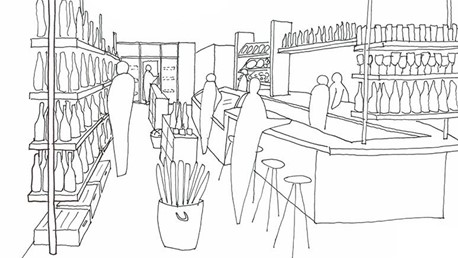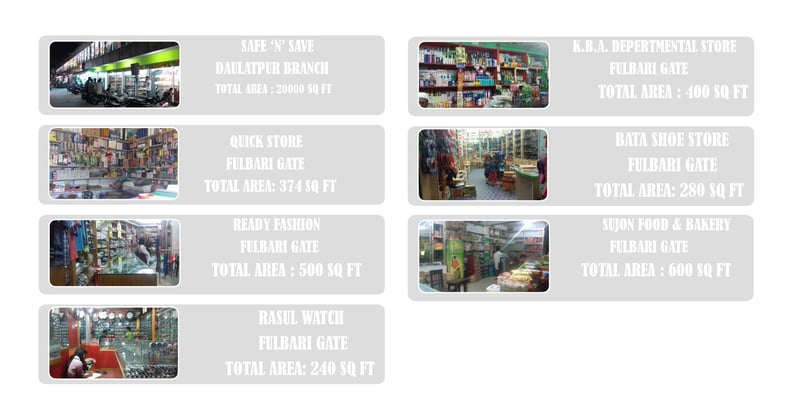Alteration Of Retail Space Fixture Considering Ergonomic Assessment Of Bangladeshi People
In this study, we compared the dimensions and ergonomic aspects of various furniture from a successful retail chain as well as individual retail shops (as unique shops are also a popular shopping medium in Bangladesh) with the Times Saver standard, and we attempted to determine how much change is needed in the fixtures of the retail space for the people of Bangladesh through ergonomic assessment.
ARCHITECTURAL STUDYSURVEY
Muhammad Golam Sami, Mahmuda Yasmin Dola
2/24/20183 min read


Image Courtesy _ https://moss-design.com/coming-soon-appellation/
Consumer or retail space has been designed since dawn and is inextricably linked to civilization [1]. This evolution of the modern supermarket began with the Greek Agora and took time. Markets and retail spaces [1] evolved in various ways, such as city-centered, religion-centered, or culture-centered, and eventually evolved into the human ergonomic-focused retail super shop. The lane or aisle is between racks of air-conditioned supershops housed within a building and occupies the historic site of shops lined on both sides of a street or passage. Different sections of supermarkets have sprouted up in place of antique bazaars, as have various shops such as pharmaceutical, grocery, furniture, and novelty stores. In addition, human connectivity or ergonomics is closely related to this self-service retail area. An architect needs to examine the ergonomics of retail space to build various furniture or ergonomic characteristics. In general, ensuring that the material we read is appropriate to the setting is critical when studying ergonomics. Because the advantages and efficient spatial benefits of retail spaces and super shops will be ineffective if the human-centered design we create is not valuable to them. Average human anthropometrics typically vary by environment. Thus, the average human anthropometrics in Bangladesh will differ from that of the United States. In this study, we compared the dimensions and ergonomic aspects of various furniture from a successful retail chain and individual retail shops (as unique shops are also popular shopping mediums in Bangladesh) with the Times Saver standard. We attempted to determine how much change is needed in the retail space fixtures for the people of Bangladesh through ergonomic assessment.


Figure 1: Surveyed Retail Spaces at Khulna, Bangladesh
Common features in a retail space:
Counter
Main and secondary public aisles
Tall cases & showcases
Trolley
Changing room




Functional Flow Of A Retail Chain:
Comparison between standard fixtures and field-surveyed furniture:
Finally, here are some observations from our field survey:
1. People in Bangladesh have a lower average crotch height than the norm, yet in some crotch height-based adjustments, people prefer to stand typically upright because backbone problems are widespread in this nation. The standing fixtures' height is somewhat greater than usual in that situation.
2. Because standard anthropometric measures for Bangladeshis are low, trolleys are meant to be tiny and maneuverable.
3. Because grocery products are typically collected by people, grocery racks are designed to be shorter than standard, and shelves are designed to be lower than average height, with the maximum feasible depth to supply more goods at less height.
4. The grocery rack design requirements are also applied to stationery products.
5. Standard measurements for home and electrical appliance racks are offered Because home and electronics items are produced to worldwide standards.
6. Bangladeshi average human anthropometrics were used to reduce shelf height for shoes and bags.
7. The height of men's and women's clothes hangers has been slightly lowered. This is also determined by the typical dress size. In Bangladesh, a standard M size is similar to a L size.
8. Generally, bakers do not maintain a set size in these circumstances; instead, individual preference is prioritized.
9. Standard ergonomics are followed when beverage and organic racks are kept to standard or when freezing racks or chillers are purchased directly from China.
10. In Heber Dashery, Millenary, the Bangladesh standard must be maintained.
11. It is critical to maintain the quality in the case of showcases since it is not determined which item or division it will be in.
Survey Acknowledgement: Kaniz Fatema Keya
References:
1. Chaplya, T. (2023). The Public and/or Private Nature of Commercial Space in History: From Antiquity to the Present. Ideas and Ideals.
Meet The Authors


Muhammad Golam Sami
B. Arch, Khulna University of Engineering & Technology, Khulna, Bangladesh Architect | Futurist | Sustainable Design Expert
Operational Head, ADORA Studios, Bangladesh
Founder, samism.org
Lecturer, Department of Architecture
Northern University of Business & Technology


Mahmuda Yasmin Dola
B. Arch, Khulna University of Engineering & Technology, Khulna, Bangladesh Architect | Analytical Practitioner
Head of Construction, ADORA Studios, Bangladesh
CMO & Head of Construction, SS Construction & Power Solution, Bangladesh
Related ARTICLES
Related PROJECTS
CAFE LIBRARY: HOSPITAlity within tranquility
The primary goal of this project was to create a cafe library in the crowded city center of Khulna that would offer a calm setting and friendliness. Our key challenge was to figure out how to replicate the peaceful environment because noise pollution in the busy city center interferes with it.
Image: Cafe Library Design Project ~ North Elevation
Location: Shibbari, Khulna ; Year: 2018





